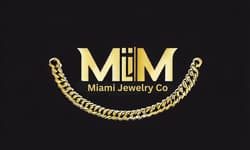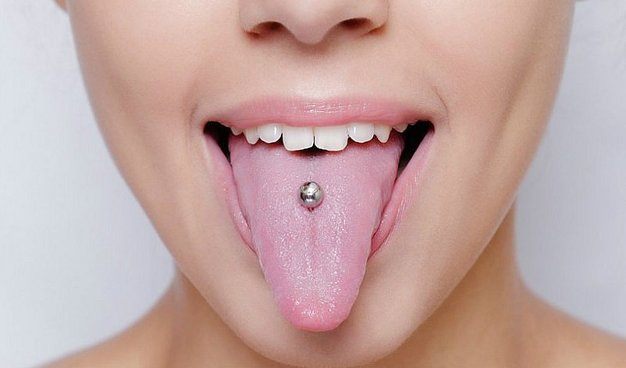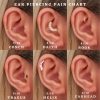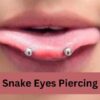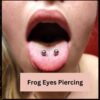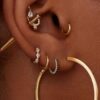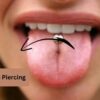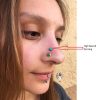Tongue Piercing
What Is The Safest Tongue Piercing?
Tongue piercings can be a stunning statement, but the fear of complications can be daunting. Painful aftermaths, infections, even speech troubles – all real issues that can stem from a piercing gone awry. But here’s the solution: knowledge and proper care.
When seeking the safest option for tongue piercing, one should consider the ‘Midline Tongue Piercing.’ Positioned directly along the tongue’s central groove, it penetrates the lingual septum—a thin, fibrous membrane. This approach, akin to the piercing of the nasal septum, targets the thinnest section of the tongue’s membrane. This strategic placement ensures not only a more straightforward healing trajectory but also a minimized risk of potential complications. It’s the inherent attributes of the lingual septum that underscore the safety of the Midline Tongue Piercing
In this guide, we’ll cover:
- Midline Tongue Piercing
- Exploring Other Piercing Types
- Safety First:
- Best Practices:
- Aftercare:
Contents
Midline Tongue Piercing – The Safest Tongue Piercing
The most common and safest type of tongue piercing is the midline tongue piercing. This is when the jewelry is placed in the center of the tongue, about 3/4 of an inch from the tip. It is usually done with a straight barbell that has balls on both ends. The barbell should be made of high-quality metal, such as titanium, surgical steel, or gold.
The midline tongue piercing is considered the safest type of tongue piercing because it has the least chance of damaging the nerves, blood vessels, and muscles of the tongue. It also has a faster healing time than other types of tongue piercings, usually taking about 4 to 6 weeks to heal completely. However, this does not mean that the midline tongue piercing is risk-free. It can still cause infections, swelling, pain, and difficulty eating and speaking.
To prevent these problems, you need to take good care of your midline tongue piercing and follow some basic tips:
- Rinse your mouth with a saline solution or an alcohol-free mouthwash after every meal and drink.
- Avoid spicy, acidic, hot, or hard foods that can irritate your tongue.
- Avoid smoking, drinking alcohol, or using drugs that can slow down your healing process.
- Avoid kissing or oral sex until your tongue piercing is fully healed.
- Clean your jewelry regularly with a mild soap and water.
- Check your jewelry for any signs of damage or loosening and replace it if necessary.
- Visit your piercer or dentist if you notice any signs of infection, such as redness, pus, fever, or bad odor.
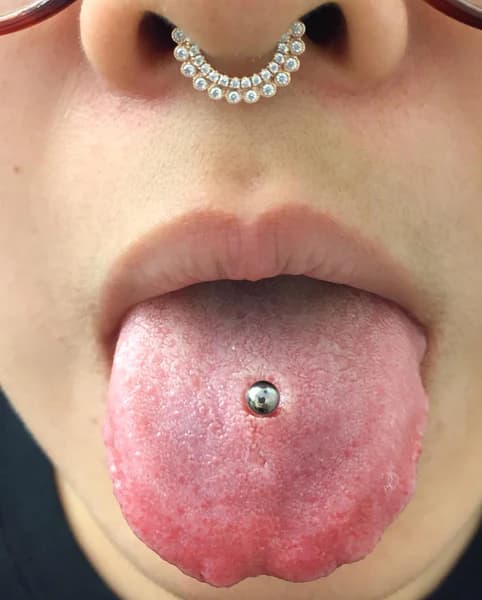
Other Types of Tongue Piercings
Besides the midline tongue piercing, there are some other types of tongue piercings that you may have heard of or seen. These include:
- Frog Eyes: This is when two piercings are done on either side of the tongue, resembling snake fangs.
- Snake eyes: This is when a curved barbell is inserted horizontally through the tip of the tongue, creating the illusion of two eyes.
- Horizontal: This is when a barbell is inserted horizontally through any part of the tongue.
- Vertical: This is when a barbell is inserted vertically through any part of the tongue.
- Frenulum: This is when a small ring or stud is placed under the tongue, on the thin tissue that connects the tongue to the floor of the mouth.
These types of tongue piercings may look cool or unique, but they are also more dangerous and complicated than midline tongue piercing. They have a higher risk of damaging the nerves, blood vessels, and muscles of the tongue. They also have a longer healing time than the middle tongue piercing, usually taking about 8 to 12 weeks to heal completely. Moreover, they can cause more problems with eating, speaking, swallowing, and oral hygiene.
Therefore, if you are thinking about getting any of these types of tongue piercings, you should be very careful and consult a professional piercer before making your decision. You should also be prepared to deal with more pain and discomfort during and after the procedure. You should also follow the same aftercare tips as for the middle tongue piercing and monitor your oral health closely.
What Makes a Piercing “Safe?”
Walking into the world of piercings, you’ll quickly realize that safety isn’t a one-size-fits-all deal. Throughout my adventures with body modifications, I’ve garnered a few golden nuggets of wisdom. Not all piercings are created equal.
When it comes to the tongue, three pivotal factors stand out:
- The Expertise of the Piercer: You wouldn’t let just anyone with a needle near your skin, would you? The same applies to your tongue. A professional, experienced piercer knows the anatomy of the tongue, the right spot to pierce without hitting vital nerves, and the proper sterile procedures to avoid infections.
- Quality of Jewelry: This isn’t where you want to skimp. Invest in high-quality, hypoallergenic metals like titanium or surgical steel. Not only do they look better, but they’re also less likely to cause reactions or infections.
- Commitment to Aftercare: The piercing itself is just step one. How you care for it subsequently can make or break your piercing experience.
Best Practices for Safe Tongue Piercings
Before I got my tongue pierced, I spent countless hours researching. And trust me, it paid off.
Here’s my advice to you:
- Pick the Right Studio: Look for one with sterling reviews, certifications, and a reputation for hygiene. A studio that’s been around for a while usually indicates they know their craft.
- Prepare Yourself with Questions: Don’t be shy. Ask about their sterilization procedures, their experience with tongue piercings, and even their choice of jewelry.
- Trust Your Gut: If something feels off or if you’re not getting clear answers, it’s okay to walk away and find another piercer.
- Related: Snake Eyes Piercing Near Me
The Aftercare Regime: Ensuring Safety Post-Piercing
Once the needle’s through, the real journey begins. Your tongue will be your focus for the next few weeks. Cleaning it with non-alcoholic mouthwash after every meal, avoiding spicy or hot foods, and steering clear of playing with the jewelry is essential. I can’t stress enough how these simple measures can prevent complications and ensure a smooth healing process.
The Long-term Commitment
A tongue piercing isn’t a “set it and forget it” deal. Regular check-ups with your piercer, especially during the first year, are a must. Clean your jewelry, be mindful of any changes, and listen to your body. It will tell you if something’s amiss.
FAQs
Are any tongue piercings safe?
Yes, when performed by a professional in a sterile environment, many tongue piercings are safe. It’s essential to follow aftercare instructions carefully and be aware of potential complications like infections, tooth damage, or gum erosion. Regular check-ups and maintaining oral hygiene can prevent most issues.
What is the best tongue piercing?
The “best” tongue piercing often depends on individual preferences and anatomy. However, the midline piercing, which is a single piercing placed in the center of the tongue, is the most common and generally considered the safest due to fewer complications and quicker healing times.
What is the most comfortable tongue ring?
Flat-backed labret studs are often considered the most comfortable tongue rings, especially for fresh piercings. Their flat base minimizes irritation and potential damage to the teeth and gums. As the piercing heals, wearers can explore various materials and styles to find what feels best for them.
What type of tongue cannot get a tongue piercing?
A tongue that has pronounced webbing (frenulum) or veins in the center may not be suitable for a standard midline piercing. It’s essential for a professional piercer to evaluate the anatomy of the tongue to determine the best placement or if a piercing is advisable at all.
What can I use instead of a tongue ring?
If someone doesn’t want a permanent tongue ring but wants a similar aesthetic, they can opt for temporary options like tongue tattoos or tongue ring stickers. These provide a temporary look without the commitment or potential risks of a piercing.
How can I reduce the swelling and pain of a new tongue piercing?
Some ways to reduce the swelling and pain of a new tongue piercing are:
Suck on ice chips or frozen fruit to numb your tongue and reduce inflammation.
Take over-the-counter painkillers, such as ibuprofen or acetaminophen, to ease the discomfort.
Elevate your head when sleeping to prevent blood from pooling in your tongue.
Avoid touching or playing with your tongue piercing to prevent irritation and infection.
Final Words – What Is The Safest Tongue Piercing
Tongue piercing is a personal choice that can have both positive and negative effects on your appearance and health. The safest type of tongue piercing is the midline tongue piercing because it has the least chance of causing complications and has a faster healing time.
However, even the midline tongue piercing requires proper care and hygiene to prevent infections and other problems. If you are interested in other types of tongue piercings, such as venom, snake eyes, horizontal, vertical, or frenulum, you should be aware of their risks and challenges and consult a professional piercer before choosing them. Alternatively, you can explore other ways to express yourself without risking your oral health.

Camila Luna is a passionate jewelry enthusiast and content creator at Miami Jewelry Co. With a focus on providing high-quality, Miami-style jewelry, Camila and her team specialize in a wide range of jewelry that includes bracelets, necklaces, earrings, and more
